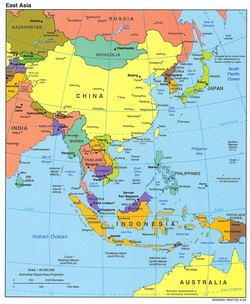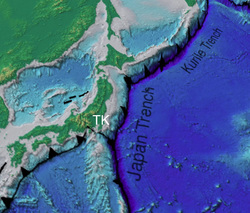East Asia is our next stop.
The countries that are a part of East Asia are China, Mongolia, North Korea, South Korea, Japan and Taiwan.
The First Feature is the Gobi Desert.
The First Feature is the Gobi Desert.
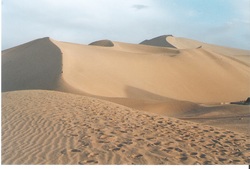
The Gobi Desert is known as one of the great deserts. It is the largest desert in China and fourth largest in the world. It covers part of Mongolia and China. It is 500,000 sq. miles and covers the southern 1/3 part of Mongolia. The Gobi is really a very dry grassland that turns into desert where it is overgrazed and has rocky hard packed terrain. The Himalayan Mountains prevent the rain clouds from reaching the desert. The Gobi is extremely hot during the day with freezing temperatures at night. Most of the little animals here are gerbils, hamsters, hedgehogs and hares. The larger animals are gazelle's and mountain sheep.
Then next feature is the Turfan Depression.

The Turfan Depression is a deep mountain basin located in Northwestern China. This fault trough descendings 508 feet below sea level and makes up 20,000 square miles. The winters have temperatures around 14 degrees and the summer in the 90's. This helps with the farming and most of the agriculture grown is fruit. The two common fruits are Hami melons and grapes. The eastern part of the depression you will find petroleum. Here, natural gas is an important part of the economic system.
Now lets take a look at the Japan Trench.
The Japan Trench is a trench located on the floor of the Pacific Ocean in northeastern Japan. It is part of the Pacific Ring of Fire. The deepest part of the trench is around 29, 527.6 feet. The trench extends from Kuril Islands to the Bonin Islands. When the Pacific plate subducted the Eurasian plate it created the trench. The tsunamis and earthquakes in Japan are created from the Japan Trench.
The next feature I want to talk about is Mount Fuji.
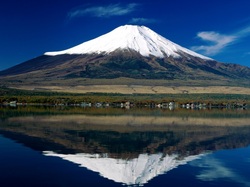
Mount Fuji is a cinder cone volcano in the middle of Japan. The eruptions that happen in this volcano are ash, bomb and cinder. Mount Fuji is the tallest volcano and highest mountain in Japan. Mount Fuji is still an active volcano even though it has not erupted since November 24, 1707 . Mount Fuji is a tourist spot for climbers. People come from all over to see it. Mount Fuji lays over the top of two volcanos the Komitake volcano and the "Old Fuji volcano."
The last feature I want to see is Huang He River.
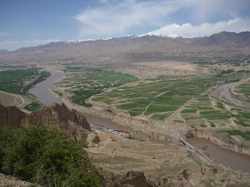
The Huang He river is approximately 5,500 feet long and is the second largest river in China. The river is called the "Yellow River" because of the yellow silt that it carries through it and empties it out into the delta. The river flows in an easterly direction in northern China to the Gulf of Bohai. This river has had so many floods that the levees have been breached more that 1,500 times.
Climate:
The climate in East Asia is a dry interior west and a wet monsoon east. The west part of East Asia has intense cold winters and intensely hot summers. This is where you will find tropical vegetation. The eastern part of of Asia is where you will find monsoon like weather. The winters are Eurasian land mass and warm summers. In the northeast the summers are wet, hot and winters are cold because they are close to the sea. The winters in Japan are severe and in autumn there is snow instead of rain.
Population:
East Asia is the most populated region in the world. The region is unevenly distributed with 90% of the population living on only 1/6 of the land area. Japan is heavily populated in Tokyo and Yokohama through the islands of Shikoku and Kyusu and is the most heavily populated zone in the world. Population is declining in China and the Chinese are now having only 1 child per family. Japans growth rate is the lowest in the region. In Mongolia and North Korea women still have 2 or more kids. East Asia is having and epidemic of HIV-AIDS. The age group affect by the disease is ages 15-49. According to the Population Reference Bureau there are 140,000 infected per year.
Agriculture:
In East Asia 4% of the population farms for a living. Along the coasts is where you will find the fishing villages. There are approximately 4,000 fisheries that have tuna, halibut, mackerel and salmon. During the winter dry season they cultivate rice paddies. Tibetan herders raise the cattle, sheep and horses. Some of the other crops scattered throughout the region is tea bushes and orchards. Japan is the world's largest consumers of foreign agriculture products and has the highest food prices (Pulsipher & Pulsipher 2008).
Gender Roles:
Mongolian women are considered equal to men. They are valuable leaders to the government and earned pensions just like the men. Because of their ability to work outside the home they earn enough money so if they wanted to they could leave a marriage and support children. Some of the jobs they hold are as teachers, judges and party officials. The women can attended institutions of higher education too. The women are the ones who actually chose which stock to breed, care for young animals and preserve meat and milk and produce products from hide and hairs. Boys and girls are taught to ride horses at a young age. Both genders help with herding the cattle. Women do the daily house chores while men herd the cattle and plant barley and wheat. Women gained legal protection and have access to education, jobs, health care and housing.
Religion:
The main religions are Buddhism, Taoism, Islam, Catholicism and Protestantism. Citizens of China may freely choose and express their religious beliefs, and make clear their religious affiliations. In Mongolia the religion is Shamanism which is an animist religion with an arsenal of beliefs and practices in which a shaman not necessarily is involved (Mongoluls.net 2002-2007). Korea is a combination of indigenous beliefs and creeds, such as Confucianism, Daoism, and Buddhism. In Japan Shinto and Buddhism are the two religions and are combined together and practiced together. Taiwan has a total of 13 religions that are practiced. These religions are Buddhism (the most popular), Taoism, Catholicism, Protestantism, Hsuan-yuan Chiao, Islam, Li-ism, Tenrikyo, Baha'i, T'ienti Teachings, Tien Te Chiao, I-Kuan Tao, and Mahikarikyo.
Resources:
As mentioned earlier petroleum is the major economic resource in eastern China. Mining industries are another source of income from coal, iron ore, gold, lead, tungsten and copper. Other resources through out East Asia are pyrites, salts and fluorspar.
Environmental Issues:
Some of the environmental issues in East Asia are erosion, deforestation, pollution of farmland and water. China's forests and grasslands are degrading fast from soil erosion, salinization and water scarcity. The manufacturing companies are creating hazardous wastes from not properly processing them because of costs that they can't afford. These wastes are eliminated through the air and dumped into the rivers creating air and water pollution.
Transportation:
Japan is one of the most developed regions in transportation. Because of the difficulties for road construction because of the high population the road systems are inadequate for the cars. Shinkansen trains are a major source of transportation. They travel at high speeds and are very punctual. Korea uses cars for transportation but because it is growing so rapidly it is causing congestion on the roads and it is difficult to find parking. Because of this they are trying to focus more on the subway system. Airway, railroad and water ways are also other forms of transportation used.
And finally Cuisine!
There is a variety of flavors in East Asia from Chinese, Indian and European. Spices and different flavors is the popular choices found here. Some of the ingredients used in cooking are coconut milk, lemon grass, sugar, basil, fish paste, and chili. Indonesians are considered to have the most exotic flavors. Rice is a main staple of this region and so is soy and fish sauces. Vietnamese are vegetarians and eat rice and soup dishes and the rest cook with meat.
The climate in East Asia is a dry interior west and a wet monsoon east. The west part of East Asia has intense cold winters and intensely hot summers. This is where you will find tropical vegetation. The eastern part of of Asia is where you will find monsoon like weather. The winters are Eurasian land mass and warm summers. In the northeast the summers are wet, hot and winters are cold because they are close to the sea. The winters in Japan are severe and in autumn there is snow instead of rain.
Population:
East Asia is the most populated region in the world. The region is unevenly distributed with 90% of the population living on only 1/6 of the land area. Japan is heavily populated in Tokyo and Yokohama through the islands of Shikoku and Kyusu and is the most heavily populated zone in the world. Population is declining in China and the Chinese are now having only 1 child per family. Japans growth rate is the lowest in the region. In Mongolia and North Korea women still have 2 or more kids. East Asia is having and epidemic of HIV-AIDS. The age group affect by the disease is ages 15-49. According to the Population Reference Bureau there are 140,000 infected per year.
Agriculture:
In East Asia 4% of the population farms for a living. Along the coasts is where you will find the fishing villages. There are approximately 4,000 fisheries that have tuna, halibut, mackerel and salmon. During the winter dry season they cultivate rice paddies. Tibetan herders raise the cattle, sheep and horses. Some of the other crops scattered throughout the region is tea bushes and orchards. Japan is the world's largest consumers of foreign agriculture products and has the highest food prices (Pulsipher & Pulsipher 2008).
Gender Roles:
Mongolian women are considered equal to men. They are valuable leaders to the government and earned pensions just like the men. Because of their ability to work outside the home they earn enough money so if they wanted to they could leave a marriage and support children. Some of the jobs they hold are as teachers, judges and party officials. The women can attended institutions of higher education too. The women are the ones who actually chose which stock to breed, care for young animals and preserve meat and milk and produce products from hide and hairs. Boys and girls are taught to ride horses at a young age. Both genders help with herding the cattle. Women do the daily house chores while men herd the cattle and plant barley and wheat. Women gained legal protection and have access to education, jobs, health care and housing.
Religion:
The main religions are Buddhism, Taoism, Islam, Catholicism and Protestantism. Citizens of China may freely choose and express their religious beliefs, and make clear their religious affiliations. In Mongolia the religion is Shamanism which is an animist religion with an arsenal of beliefs and practices in which a shaman not necessarily is involved (Mongoluls.net 2002-2007). Korea is a combination of indigenous beliefs and creeds, such as Confucianism, Daoism, and Buddhism. In Japan Shinto and Buddhism are the two religions and are combined together and practiced together. Taiwan has a total of 13 religions that are practiced. These religions are Buddhism (the most popular), Taoism, Catholicism, Protestantism, Hsuan-yuan Chiao, Islam, Li-ism, Tenrikyo, Baha'i, T'ienti Teachings, Tien Te Chiao, I-Kuan Tao, and Mahikarikyo.
Resources:
As mentioned earlier petroleum is the major economic resource in eastern China. Mining industries are another source of income from coal, iron ore, gold, lead, tungsten and copper. Other resources through out East Asia are pyrites, salts and fluorspar.
Environmental Issues:
Some of the environmental issues in East Asia are erosion, deforestation, pollution of farmland and water. China's forests and grasslands are degrading fast from soil erosion, salinization and water scarcity. The manufacturing companies are creating hazardous wastes from not properly processing them because of costs that they can't afford. These wastes are eliminated through the air and dumped into the rivers creating air and water pollution.
Transportation:
Japan is one of the most developed regions in transportation. Because of the difficulties for road construction because of the high population the road systems are inadequate for the cars. Shinkansen trains are a major source of transportation. They travel at high speeds and are very punctual. Korea uses cars for transportation but because it is growing so rapidly it is causing congestion on the roads and it is difficult to find parking. Because of this they are trying to focus more on the subway system. Airway, railroad and water ways are also other forms of transportation used.
And finally Cuisine!
There is a variety of flavors in East Asia from Chinese, Indian and European. Spices and different flavors is the popular choices found here. Some of the ingredients used in cooking are coconut milk, lemon grass, sugar, basil, fish paste, and chili. Indonesians are considered to have the most exotic flavors. Rice is a main staple of this region and so is soy and fish sauces. Vietnamese are vegetarians and eat rice and soup dishes and the rest cook with meat.
References:
Absolute Astronomy (2011). Topic: Japan Trench. Retrieved from http://www.absoluteastronomy.com/topics/JapanTrench
Asianinfo.org (2010). Your complete Resource On Asia: Transportation in Japan. Retrieved from http://www.asianinfo.org
East Asia. (2011). In Encyclopædia Britannica. Retrieved from http://www.britannica.com/EBchecked/topic/176516/East-Asia
Mongoluls.Net (2002-2007). Religion in Mongolia: A History of Religion in Mongolia. Retrieved from http://mongoluls.net/mongolian-religion
New World Encyclopedia (Last Modified 2 April 2008 ). Organizing knowledge for happiness, prosperity, and world peace: Gobi Desert. Retrieved from http://www.newworldencyclopedia.org/entry/GobiDesert
New World Encyclopedia (Last Modified 19 January 2009). Organizing knowledge for happiness, prosperity, and world peace: Mount Fuji. Retrieved from http://www.newworldencyclopedia.org/entry/MountFuji
Pulsipher, L. M., and Pulsipher, A. (2008). World Regional Geography: Global Patterns, local lives (4th ed.). New York: W. H. Freeman and Company.
Turfan Depression. (2011). In Encyclopædia Britannica. Retrieved from http://www.britannica.com/EBchecked/topic/609668/Turfan-Depression
Yahoo Images (no copyright). Mount Fuji. Retrieved from http://images.search.yahoo.com
Absolute Astronomy (2011). Topic: Japan Trench. Retrieved from http://www.absoluteastronomy.com/topics/JapanTrench
Asianinfo.org (2010). Your complete Resource On Asia: Transportation in Japan. Retrieved from http://www.asianinfo.org
East Asia. (2011). In Encyclopædia Britannica. Retrieved from http://www.britannica.com/EBchecked/topic/176516/East-Asia
Mongoluls.Net (2002-2007). Religion in Mongolia: A History of Religion in Mongolia. Retrieved from http://mongoluls.net/mongolian-religion
New World Encyclopedia (Last Modified 2 April 2008 ). Organizing knowledge for happiness, prosperity, and world peace: Gobi Desert. Retrieved from http://www.newworldencyclopedia.org/entry/GobiDesert
New World Encyclopedia (Last Modified 19 January 2009). Organizing knowledge for happiness, prosperity, and world peace: Mount Fuji. Retrieved from http://www.newworldencyclopedia.org/entry/MountFuji
Pulsipher, L. M., and Pulsipher, A. (2008). World Regional Geography: Global Patterns, local lives (4th ed.). New York: W. H. Freeman and Company.
Turfan Depression. (2011). In Encyclopædia Britannica. Retrieved from http://www.britannica.com/EBchecked/topic/609668/Turfan-Depression
Yahoo Images (no copyright). Mount Fuji. Retrieved from http://images.search.yahoo.com
